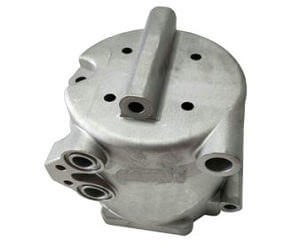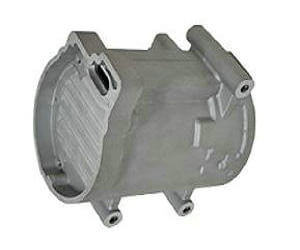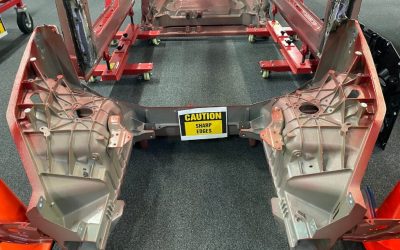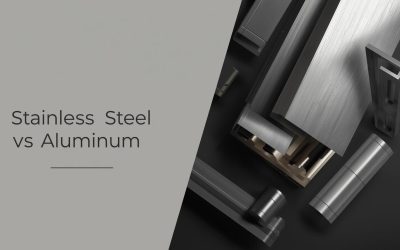What is semi solid aluminum die casting
Semi-solid aluminum die casting is a manufacturing process that involves injecting the aluminum alloy in a semi-solid state into a mold to form complex geometric shapes and designs. In this process, the aluminum is heated to a temperature between its solidus and liquidus points, which is typically around 580 to 610 degrees Celsius.
At this temperature range, the aluminum is partially solidified, with a solid fraction of roughly 30% to 70% by volume. This semi-solid state is achieved by rapidly cooling the molten aluminum alloy and maintaining it at a specific temperature range to prevent complete solidification.
The semi-solid aluminum alloy is then injected into a complex mold using high-pressure injection, resulting in high-quality, intricate components with excellent surface finishes, dimensional accuracy, and mechanical properties. The semi-solid aluminum die casting process has several advantages over traditional die casting methods, such as reduced porosity, enhanced fluidity, and increased mechanical strength.

Automotive air conditioner casting part
The semi-solid aluminum die casting process is commonly used in a wide range of industries, including automotive, aerospace, electronics, and consumer products, where complex components with high dimensional accuracy and mechanical properties are required.
Advantages of Semi Solid Aluminum Die Casting
Semi solid aluminum die casting offers a range of advantages over traditional die casting methods. One of the main advantages is improved mechanical properties. Due to the partial solidification of the feedstock, semi solid aluminum die castings exhibit higher strength, ductility, and toughness. This makes them ideal for parts that require high reliability and durability, such as automotive and aerospace components.
Another benefit of semi solid aluminum die casting is the reduced porosity of the finished product. Porosity refers to voids or holes in the casting, which can affect the mechanical properties and overall quality. Since semi solid aluminum die casting involves a partial solidification of the feedstock, it results in less formation of gas during the solidification process, leading to a reduced number of porosities. This results in high-quality and consistent parts with fewer defects.
Additionally. semi solid aluminum die casting has better thermal conductivity. Semi solid aluminum die casting is an excellent choice for applications that require high thermal conductivity. This is because aluminum has a high thermal conductivity of 237 W/mK, which is more than three times higher than that of steel. This makes aluminum die castings highly effective at dissipating heat, which is essential for components such as heat sinks in electronic devices and engine components in automotive applications.
Moreover, the semi solid aluminum die casting process allows for precise control over the flow of molten metal, resulting in parts with uniform wall thickness and distribution. This minimizes the formation of hot spots, which can contribute to thermal conductivity issues and overheating. In situations where thermal management is critical, semi solid aluminum die casting is the preferred choice due to its excellent thermal conductivity properties.
Additionally, the high thermal conductivity of aluminum die castings can also result in energy savings in various applications. For instance, in HVAC systems, heat exchangers made from aluminum die castings can transfer heat more efficiently, leading to reduced energy consumption and increased efficiency.
Furthermore, semi solid aluminum die casting offers a better surface finish than traditional die casting processes. The smooth and uniform surfaces result from the partial solidification of the feedstock, which minimizes the formation of shrinkage porosity and enables greater control of the flow of molten metal into the mold.
Process of Semi Solid Aluminum Die Casting
The semi solid aluminum die casting process involves several steps that differentiate it from traditional die casting processes. The process starts with the production of the feedstock, which is prepared by partially solidifying the molten metal. Once the feedstock is ready, it is injected into the mold at lower pressure and temperature than traditional die casting.
The injection is carried out at a high velocity, which ensures good mold filling. Once the mold is filled, the casting is allowed to cool and solidify. The cooling and solidification process is carefully controlled to ensure the right balance between the solid and liquid phases and to minimize porosity and other defects.
Applications of Semi Solid Aluminum Die Casting
Semi solid aluminum die casting has many applications in different industries. Its improved mechanical properties make it suitable for parts that require high reliability and strength. It is commonly used in automotive parts such as engine blocks, transmission casings, and suspension components. In the aerospace industry, it is used for components such as airframe structures, turbine blades, and engine components.
Moreover, semi solid aluminum die casting is also used in electrical components such as heat sinks, LED housings, and electronic enclosures. The process’s ability to produce parts with high surface finish makes it attractive for consumer electronics, lighting, and other industries where aesthetics are important.
Comparison with Other Die Casting Processes
Compared to traditional die casting methods, semi solid aluminum die casting has several differences and similarities. One of the main differences is that semi solid aluminum die casting involves partial solidification of the feedstock, which results in improved mechanical properties, reduced porosity, and better surface finish. Traditional die casting, on the other hand, produces parts by cooling and solidifying molten metal at high pressure.
In terms of similarities, both methods involve injecting molten metal into a mold and allowing it to solidify. Additionally, both methods can be used for producing parts with similar shapes and sizes. However, due to its improved mechanical properties and surface finish, semi solid aluminum die casting can produce parts with greater precision and consistency.
Different between high-pressure die casting and semi-solid die casting
The key points of difference between high-pressure die casting and semi-solid die casting are as follows:
- Material consistency: High-pressure die casting uses fully liquid molten metal, while semi-solid die casting uses a semi-solid slurry of metal with a consistency similar to soft butter.
- Filling the mold: In high-pressure die casting, molten metal is injected into the mold under high pressure, whereas semi-solid die casting uses a low-pressure process to fill the mold with the semi-solid metal slurry.
- Precision: Semi-solid die casting allows for more precise filling of complex mold cavities, resulting in higher quality parts with superior properties than high-pressure die casting.
- Density and porosity: Parts produced by semi-solid die casting have a higher density and lower porosity compared to those produced by high-pressure die casting.
- Strength and quality: Due to the higher density and lower porosity, semi-solid die casting produces parts with higher strength and better overall quality than high-pressure die casting.
Semi-solid die casting is a more precise and controlled process that produces higher quality parts with better properties than high-pressure die casting. However, it is generally more expensive and time-consuming than high-pressure die casting.
Challenges and Limitations of Semi Solid Aluminum Die Casting
Despite its many benefits, semi solid aluminum die casting also has some challenges and limitations. One of the main limitations is the high equipment costs associated with this process. The machines used for semi solid aluminum die casting are specialized and costly, making it challenging for small-scale manufacturers to adopt this method. Thus, it is mostly used by larger manufacturing facilities that can justify the high initial investment.
Another limitation of semi solid aluminum die casting is the limited availability of materials. Not all materials can be used in the semi-solid state, making it challenging to produce parts that require specific alloys. Additionally, the process has a limited range of casting size and shape, which may not be suitable for all manufacturing needs.

Automotive air conditioner Compressor part
Future Research and Development
The development of semi solid aluminum die casting is ongoing. Researchers are working to further improve the process and overcome its limitations. One area of research is the development of new alloys that can be used in the semi-solid state and can produce parts with even better mechanical properties and durability.
Moreover, advancements in simulation technology are enabling the optimization of the semi solid aluminum die casting process, improving the casting quality and efficiency. This is necessary for the process to become more mainstream and accessible to a wider range of manufacturing facilities.
How to find semi-solid aluminum die casting manufacturers and Suppliers
Finding semi-solid aluminum die casting suppliers is not easy, which is a specialized and less common process compared to traditional aluminum die casting, may require some additional effort. Here are steps to help you find suitable suppliers:
- Online Searches: Start by conducting online searches using search engines, business directories, and industry-specific platforms. Use relevant keywords like “semi-solid aluminum die casting” or “semi-solid die casting.” This should help you identify potential suppliers.
- Industry Directories: Explore industry-specific directories and databases that list manufacturers and service providers in the field of semi-solid aluminum die casting. Some well-known directories include ThomasNet, and specialized industry association websites.
- Trade Associations: Reach out to trade associations and organizations related to the casting and manufacturing industry. They often have member directories, industry insights, and can provide recommendations. Examples include the North American Die Casting Association (NADCA) or similar organizations in your region.
- Online Marketplaces: Platforms like Alibaba and Global Sources have a wide range of suppliers offering various casting services. You can search for suppliers who specialize in semi-solid aluminum die casting on these platforms.
- Networking: Attend industry trade shows, exhibitions, and conferences related to metal casting and manufacturing. These events provide opportunities to network with industry professionals and connect with potential suppliers.
- Industry Forums and Discussion Groups: Join online forums, discussion groups, or social media groups dedicated to metal casting and manufacturing. These communities can be excellent sources for supplier recommendations and insights from others in the industry.
- Request for Proposals (RFPs): Create a detailed Request for Proposal (RFP) that outlines your specific project requirements and submit it to potential suppliers. This can help you identify suppliers who are capable of meeting your needs.
- Evaluate Experience and Reputation: Research the experience and reputation of potential suppliers. Look for customer reviews, case studies, and ask for references. Reputable suppliers should be able to provide examples of their past work and demonstrate their expertise.
- Quality Standards and Certifications: Inquire about the quality control processes, certifications, and standards adhered to by the potential suppliers. Compliance with industry standards is crucial to ensure quality and reliability.
- Site Visits and Inspections: If possible, consider visiting the facilities of shortlisted suppliers to observe their equipment, production processes, and overall capabilities.
- Cost and Lead Time Comparison: Collect quotes from different suppliers and compare not only the costs but also the lead times and any additional services or support they offer.
- Collaboration and Communication: Establish clear communication with potential suppliers to discuss your project requirements, expectations, and any specific needs. Strong communication is key to a successful partnership.
Remember to exercise due diligence in your search for semi-solid aluminum die casting suppliers, as the quality and expertise of the supplier can significantly impact the success of your project. Additionally, ensure that you have a clear understanding of your project’s technical requirements and specifications to find a supplier capable of meeting them.
Looking for high-quality semi solid die casting manufacturers for your business? Look no further than GC Precision Mould! With our extensive knowledge and experience in the industry, we are a leading China die casting manufacturer and supplier of a wide range of die casting products, including aluminum die casting, semi-solid aluminum die casting, 6061 aluminum die casting, 6063 aluminum die casting, zinc die casting, magnesium die casting and more.
Our team of skilled and experienced professionals is dedicated to providing you with the best possible die casting products that meet your unique specifications and requirements. We use only the highest-quality materials and cutting-edge die casting technologies to ensure that our products are of the highest quality and perform reliably in the most demanding applications.
Whether you need simple or complex die casting components or semi solid die casting parts, we have the expertise, technology, and resources to meet all your needs, from concept to production. So why wait? Contact us today to see how we can help take your business to the next level with our high-quality die casting solutions!





0 Comments